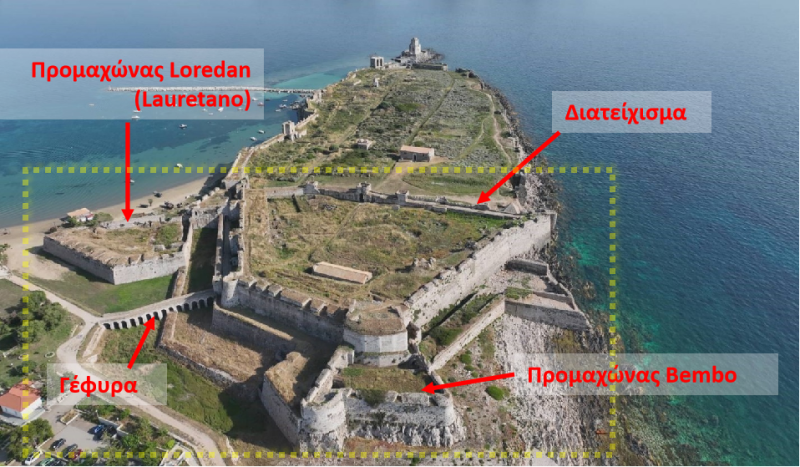“The planned interventions are aimed at stopping the phenomenon of structural disorganization of the walls, improving the monument’s resistance to the wear and tear of time and the safety conditions of visitors, the partial morphological restoration – improving the legibility of the monument”, emphasizes the Minister of Culture Lina Mendoni.
Unanimously positive comment on it Central Archaeological Council on the results of the research program for the consolidation and restoration of its northern part Castle of Methoniwhich includes the fortified Acropolis, the access route, the bastions, the wall and the gates of the Castle.
The research program prepared by the Technical University of Crete within the framework of the Cultural Development Program Agreement between the Ministry of Culture and the Region of Peloponnese, with a budget of 475,000 euroswhich also concerns the preparation of the necessary studies for the restoration and promotion of the Castle, as well as the implementation of the necessary supporting archaeological works.
THE Minister of Culture Lina Mendoni, stated: “The imposing castle of Methoni, a prominent Byzantine monument, is located at the crossroads of the sea routes of the Mediterranean. Due to its location, it has been continuously inhabited since ancient times. It is one of the most important fortresses of its time in Greece. The monument presents serious problems due to its location, as it is in direct proximity to the sea and in fact in a place where strong winds blow. The issue of the protection of Methoni Castle was set as an immediate priority after the collapse of part of the western side of the semi-circular tower, within the northern enclosure. In an autopsy that we immediately carried out, the serious structural problems of the fortress were recorded, which needed immediate treatment. The planned operations are aimed at stopping the phenomenon of structural disorganization of the walls, improving the resistance of the monument to the wear and tear of time and the safety conditions of visitors, partial morphological restoration – improving the legibility of the monument. The principles of the proposed interventions are the respect for authenticity, the preservation of all building phases, the limitation of interventions to the minimum necessary to fix the preserved parts and only in certain cases for the safety of visitors or morphological integration individual points. Through the Programming Agreement with the Region of Peloponnese, we commissioned the development of a research program and initiated the procedures, so that the studies related to the restoration of the fortified parts of the castle as well as the highlighting of its monuments can be prepared as soon as possible.”
The subject of the research program was divided into the following eight sections: North and East Wall, Bastion, Land Gate Fortification, Cross Wall, West Wall, Bembo Bastion, Loredan Bastion, West Bastion, Ditch, Northwest Bastion. For each section, historical evidence was collected, the pathology was recorded and proposals were made for the restoration of the individual architectural and structural elements. The main problems facing the fortress complex are cracks, disorganization of the wall structure and extensive collapses in the places where there is direct contact with the sea. In addition, it shows local problems in the structure of the walls, which are due to the detachment of material in recent times, resulting in structural damage but also the morphological alteration of the monument, deterioration of fragile building materials, due to humidity, traffic and visitor safety issues , especially on the western wall.
The Castle of Methoni, with an area of 93 acres, occupies a long narrow strip of land, which penetrates about 400 m. into the sea and communicates with the hinterland only from its northern side. The castle town consists of two parts. To the south stretches the city, enclosed by a simple wall with towers at regular intervals. At the southernmost end of the castle opens the gate of the Sea, which, through a stone bridge, leads to Burji, the sea fortress. In the northern part towards the hinterland, which is the most vulnerable, the Acropolis develops, known in the Ottoman period as Its Kale (inner castle). In front of the Acropolis Gate, the “Arms Square”, where the commercial and social life of Methoni was concentrated. It is surrounded to the north, east and west by walls, parts of which date back to the early and middle Byzantine period as well as the early Venetian period, during the 15th century, before the introduction and development of artillery and the rampart system. The two sections are separated by an intermediate low wall reinforced with towers entirely built during the first Ottoman period. The main gate of the castle was built by the Venetians. Access to the inside of the fortress is via a bridge, from the beginning of the 19th century. The corridor leads to a fortified enclosure, formed to protect the land gate of the city, which belongs to the medieval fortifications of the Venetians during the 15th century. The defensive shielding of the entrance is ensured by the Bembo bastion (second half of the 15th century) to the west and the Loredan bastion (1714) to the east. The walls have received interventions during the Ottoman period.
Source: Skai
I have worked as a journalist for over 10 years, and my work has been featured on many different news websites. I am also an author, and my work has been published in several books. I specialize in opinion writing, and I often write about current events and controversial topics. I am a very well-rounded writer, and I have a lot of experience in different areas of journalism. I am a very hard worker, and I am always willing to put in the extra effort to get the job done.












